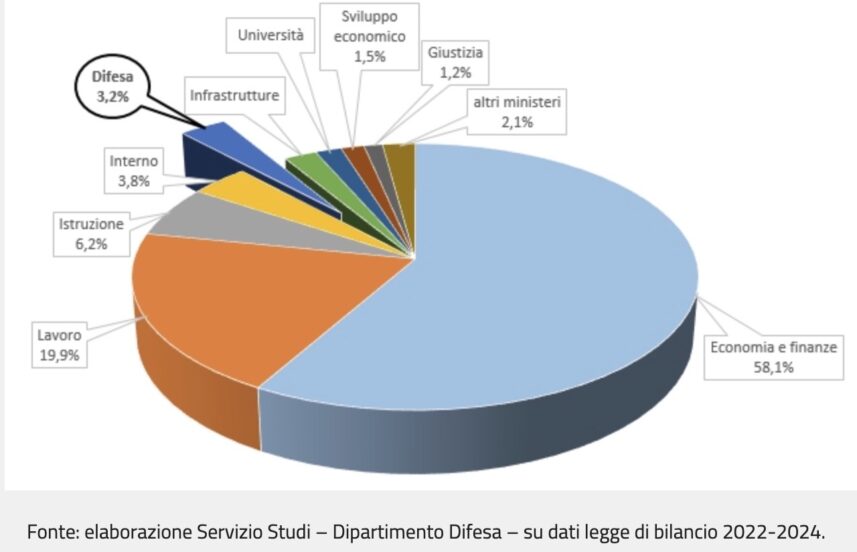(To Francis Matera) The Minister of Defense, Guido Crosetto in the Chamber he outlined the new Italian posture in the face of global challenges. In Defense, a Copernican revolution must be carried out in order to always be ready to face challenges and new threats that come not only from the East (Russia and Asia) but also from the South, from the African continent increasingly grappling with regional micro-conflicts that have effects on the Old Continent: food and energy crises and uncontrolled immigration, not to mention the recent upsurge in acts of terrorism.
A new Security and Defense policy
All European countries of reference, France e Germany have decided to launch massive appropriations for Defense. There France 400 billion by 2030 and the Germany 100 billion to be invested immediately.
Italy does not want to stay behind. The minimum objective is to increase the budget to be allocated to the Defense sector from at least 1,5 per cent to 2 per cent of GDP, because, in the face of some excellence in the weapon systems of the individual Armed Forces, we are not capable of dealing with a high-intensity conflict like the one in Ukraine. The problem that has emerged is that the national stockpile of ammunition and armaments is dwindling due to decades of apparent détente after the Cold War. We have invested in excellence while neglecting the sensitive area of recruitment, in the face of an unacceptable increase in the average age of our military personnel, which will reach 46 years by 2024. DiPaola law (L. 244/2012) to bring the army to 144 thousand units by 2024, due to budgetary needs of the time, is no longer current and sustainable.
“SIGN UP FOR THE PRP CHANNEL NEWSLETTER”
In fact, Crosetto, during a hearing in the Chamber, spoke of a structural issue to be addressed in order to make our Armed Forces adequate. According to some indiscretions from the Defense, reported by Corsera, the degree of efficiency of the heavy artillery supplied to theArmy it is now valued at around 25%, due to obsolescence. L'aeronautics it has XNUMXth generation aircraft but does not have an adequate amount of missiles. There Marina it has state-of-the-art ships but is understaffed.
In a framework that is no longer adequate, it is hoped that Parliament will act immediately with a common and non-political vision because National Security and Defense must not have political colors. The objective is therefore the 2% of GDP promised to NATO in 2014, even if many analysts think it is no longer sufficient and current. Military spending should increase to at least 2,5 percent of GDP in order to achieve an acceptable and resilient defense system. Italy today spends just over 1,5 of its GDP on defence, for a value of around 18 billion euros a year. Other funds are allocated to the Ministry of Economic Development and the Ministry of Economy and Finance for programs of new weapon systems and missions abroad, thus bringing the total budget to around 25 billion euros a year.

However, the various polls among Italians are not in favor of increasing funding for the Ministry of the Armed Forces and this is why the Meloni government has asked Brussels to be able to separate Defense investments from the Stability Pact, thus not affecting the exceeding the deficit by 3 per cent. In this way there would be a broad consensus within Parliament, with the exception of the support of the Five Stars who have already declared their opposition to the increase in spending on arms.
2% of GDP in defense budgets
The promise of NATO countries in 2014 was to increase the military budget by at least 2% of GDP. Not all have yet succeeded in fulfilling the intentions of the Alliance. Americans alone have spent about $300 billion more in real terms since making the pledge.
Il French Ministry of Defense he therefore said that the government aims to bring its spending to over 2% of gross domestic product in line with NATO commitments, but declined to provide specific forecasts. France has not consistently achieved this goal. According to NATO data, France spent about 1,8% of its GDP on defense from 2014 to 2019 and 2% in 2020, the latest year for which data was available.
La Denmark has pledged for 2033, Belgium for 2035. Some key allies are still far from the 2% target. For example, the Germany it is around 1.4%, despite the promise to invest an additional one hundred billion euros. L'Italy is at 1.5%, the Spain at 1%. Some, like the Canada, have not even confirmed this commitment.
La Britain it already spends 2,2% of GDP on defense and has not yet committed to a large increase in its military budget.
Law of Paula
Il DPP 2021-2023 points out that the progressive reduction of personnel, aimed at achieving the target set for 2024 with military personnel at 150.000 units, is in fact achieved with measures to contain public expenditure in the personnel sector which significantly affect recruitment capacity of the military component, that is, with a significant reduction in recruitment in the entire sector. This process, with particular reference to the next few years, causes stocks to fall from 172.657 units in 2017 to 171.079 units in 2018, to 169.855 units in 2019 and respectively 169.360 and 169.086 units in 2020 and 2021. 169.855 units in 2019, 167.252 units in 2020, 167.057 units in 2021 and 166.484 and 165.529 units respectively in 2022 and 2023.

